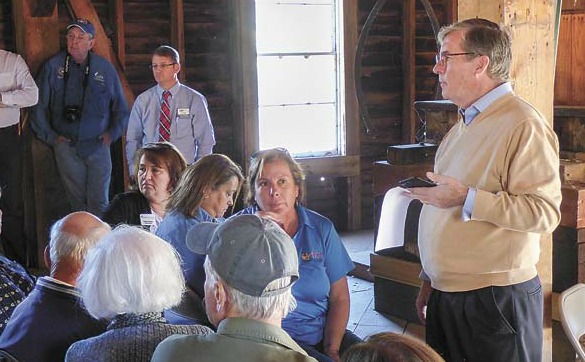Fayette County photographer Dean Breest, standing in front, was one of the speakers at a Nov. 17 meeting at Starr’s Mill to explore potential uses for the historic structure and the 17-acre site. Photo/Ben Nelms.
More than 80 people attended a Nov. 17 meeting at the historic Starr’s Mill on Ga. Highway 92 South. Residents and organization representatives spoke about beginning a conversation to explore potential uses for the mill and 17-acre site, owned for years by the Fayette County Water System,. The Kiwanis Club of Fayette County would serve as gatekeeper for future projects.
The Nov. 17 meeting was heavily attended, with many of those responding to what was essentially a call to arms by Fayette County Historical Society President Alice Reeves in a Nov. 9 letter explaining that local photographer Dean Breest and the arts community wanted to use the mill to promote the arts.
“We’d like to see it kept as a passive recreation area. Your responses are critical. We need to be vocal with our concerns,” Reeves said in the letter.
It turned out that there was more to the story. Fayette County Water System Director Lee Pope was the first to speak. The water system has owned the property on which the mill is situated for 25 years.
Pope noted what he described as the need to explore the future of the Starr’s Mill property which includes 17 acres.
The idea for the meeting, said Pope, is to have the interested parties arrive at an agreed proposal to present to the county Water Committee and, in turn, to the county commissioners.
“The meeting today is to gather interest,” said Pope. “We don’t want to harm the historical significance of the building.”
Some of those at the meeting represented other organizations around Fayette that would participate in developing and implementing the plans for the property.
“There is no goal to change the character of the building,” Breest said, even though he advocated for occasionally using the mill to display art without compromising the structure that dates to the early 1800s.
Former Fayette County Historical Society President Bobby Kerlin at the meeting said he wanted to see the mill “kept as it is and kept up. I see nothing wrong with developing the property around it, but not the mill.” Kerlin said he did not want Starr’s Mill to lose its identity.
Representatives from Southern Conservation Trust attended and expressed the organization’s desire to be part of the plans for the mill, as did the Fayette Photographic Society. Perhaps as instrumental as any group or organization, the Kiwanis Club of Fayette County previously agreed to be the gatekeeper for Starr’s Mill projects.
Perhaps the first thing to accomplish, said Pope, was to clean up the property. Beyond that, it will likely take a number of meetings of the interested parties to arrive at a plan for the area. There was no timetable established for that process.
When it came to potential projects, that is where some with the historical society were concerned. The group did not want plumbing or electricity installed, as noted in Reeves’ letter, where she said neither had ever been present in the building. Though perhaps never installed, it is noteworthy that the mill once generated and supplied electrical power to Senoia. The year was 1907, Starr’s Mill was a grist mill, lumber mill and a power generator.
Some of the proposals for the future, which will likely take years to agree upon and accomplish, if ever, include a welcome center, art gallery, a history center in an adjacent building, a 4-H wildlife center, a Boy Scout camp site and a boat ramp for Southern Conservation Trust as part of the canoe and kayak feature which begins a few miles upstream on Whitewater Creek at The Ridge Nature Area in Fayetteville.
Many in the audience did not like the idea of using the mill as the setting for an art gallery. Some also questioned constructing other buildings on the 17-acre property and others wondered if a higher use of the property might result in unwanted activity.
“(The property) needs to be used for something,” Breest said near the end of the meeting, commenting that the mill is rarely open to the public.
The issue, said County Administrator Steve Rapson, is do we want to do something with the mill property? And, if so, what?
To answer those questions there will likely be many more meetings in coming months where those interested can have their say on the answers.

Leave a Comment
You must be logged in to post a comment.